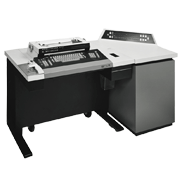Sharp launched the HAYAC-5000 in April 1974. Using firmware-controlled time slicing, the HAYAC-5000 featured a multitasking function that could run up to 15 separate programs simultaneously.
The model's primary features were as follows:
-
- (1)It used a fixed-head disk to implement virtual memory.
- (2)It used 1-kilobyte PMOS ICs for its main memory, that could be expanded up to 64 kilobytes from the basic 4 kilobytes.
- (3)Firmware, which was implemented on a Silicon-on-Sapphire (SOS) ROM chip, was used to control communication and I/O operations.
- (4)The system disk was a fixed disk and could be expanded up to 392 kilobytes from the basic 49 kilobytes.
- (5)Main memory channel devices were expanded in job units, and time slicing allowed for up to 15 simultaneous work or billing processes.
- (6)It was connectable to 11 types of peripheral devices, including CRT terminals, typewriter terminals, serial dot matrix printers, line printers, 5-megabyte cartridge disk units, magnetic cassette tape units, magnetic tape units, and communication controllers.
- (7)A proprietary interface permitted twisted-pair connections with terminals as far as 500 meters away without using a modem or other device, and the multi-CRT systems were ahead of their time.
- (8)The HAYAC-5000 was programmed using assembler and COBOL languages.
- (9)It was easy to design systems tailored to a broad range of business processes. The HAYAC-5000 came into its own when applied as a low-cost billing system, an efficient inline multi-billing system, a small-scale batch system, a data collection system with external storage, or a small-scale online system.


